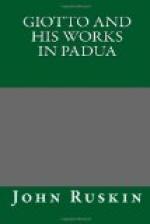* * * * *
XXVI.
THE EXPULSION FROM THE TEMPLE.
More properly, the Expulsion from the outer Court of the Temple (Court of Gentiles), as Giotto has indicated by placing the porch of the Temple itself in the background.
The design shows, as clearly as that of the Massacre of the Innocents, Giotto’s want of power, and partly of desire, to represent rapid or forceful action. The raising of the right hand, not holding any scourge, resembles the action afterwards adopted by Oreagna, and finally by Michael Angelo in his Last Judgment: and my belief is, that Giotto considered this act of Christ’s as partly typical of the final judgment, the Pharisees being placed on the left hand, and the disciples on the right. From the faded remains of the fresco, the draughtsman could not determine what animals are intended by those on the left hand. But the most curious incident (so far as I know, found only in this design of the Expulsion, no subsequent painter repeating it), is the sheltering of the two children, one of them carrying a dove, under the arm and cloak of two disciples. Many meanings might easily be suggested in this; but I see no evidence for the adoption of any distinct one.
* * * * *
XXVII.
THE HIRING OF JUDAS.
The only point of material interest presented by this design is the decrepit and distorted shadow of the demon, respecting which it may be well to remind the reader that all the great Italian thinkers concurred in assuming decrepitude or disease, as well as ugliness, to be a characteristic of all natures of evil. Whatever the extent of the power granted to evil spirits, it was always abominable and contemptible; no element of beauty or heroism was ever allowed to remain, however obscured, in the aspect of a fallen angel. Also, the demoniacal nature was shown in acts of betrayal, torture, or wanton hostility; never in valiancy or perseverance of contest. I recollect no mediaeval demon who shows as much insulting, resisting, or contending power as Bunyan’s Apollyon. They can only cheat, undermine, and mock; never overthrow. Judas, as we should naturally anticipate, has not in this scene the nimbus of an Apostle; yet we shall find it restored to him in the next design. We shall discover the reason of this only by a careful consideration of the meaning of that fresco.
* * * * *
XXVIII.
THE LAST SUPPER.




